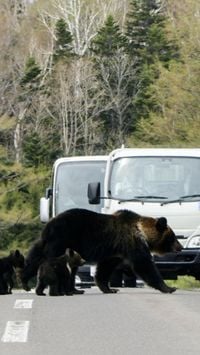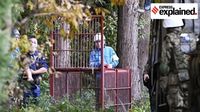In a move that has startled many both inside and outside the country, Japan has deployed its military to the northern prefecture of Akita to help tackle an unprecedented surge in bear attacks that have left residents fearful and authorities scrambling for solutions. Since April 2025, more than 100 people have been injured and at least 12 killed in bear encounters across the country, according to statistics released by the Environment Ministry at the end of October (NPR, Associated Press, Reuters). For a nation that prides itself on order and safety, these numbers are nothing short of alarming.
The deployment began in Kazuno, a city of around 30,000 known for its hot springs and apple orchards. Here, soldiers of the Self-Defense Forces (SDF) arrived in trucks and jeeps, equipped with body armor, bear spray, and large maps, ready to assist local authorities. Their mission? To set box traps baited with food, transport certified civilian hunters, and help dispose of deceased bears. Crucially, they are not authorized to use firearms for culling the animals (NPR, Reuters). As Kazuno Mayor Shinji Sasamoto told Reuters, "The townspeople feel the danger every day." The bear threat has become so pervasive that residents are advised to avoid the forests after dark, carry bells to deter bears, and, in some cases, stay home altogether. One of the nation’s top-ranked high school running teams even withdrew from a regional championship due to fears of bear attacks (Japan Running News).
Bear sightings and attacks have become a near-daily occurrence in northern Japan, especially ahead of hibernation season as bears forage for food. Reports detail bears wandering near schools, railway stations, supermarkets, and even hot springs resorts (NPR, Associated Press). In Akita prefecture alone, which has a population of about 880,000, nearly 50 people have been attacked since May, with at least four fatalities (NPR, local government data). The fear is palpable, and the impact on daily life profound. "It has affected how people live their lives, forcing them to stop going out or cancel events," Mayor Sasamoto explained to Reuters.
Japan is home to an estimated 54,000 bears, including Asiatic black bears (Selenarctos thibetanus) and brown bears (Ursus arctos), the latter of which are especially prevalent in Hokkaido, the northernmost of Japan’s four main islands (Associated Press, Reuters). Despite extensive industrialization, forests still cover about 67% of Japan’s land area, with mountains and hills occupying more than 70%—creating ample habitat for bears. As bear expert Frank van Manen told Cowboy State Daily, “There are dense human populations in the valleys, and towns and cities butt right up against the forests where bears live.”
The roots of the crisis are complex. Japan’s rural regions have been hit hard by aging and depopulation, with many younger residents moving to urban centers. This shift has left behind abandoned neighborhoods and farmland, often dotted with persimmon and chestnut trees—an irresistible lure for hungry bears. Once these animals find a reliable food source, experts say, they keep coming back (NPR, Associated Press). Takahiro Ikeda, an orchard operator in Akita, lamented to NHK television, “My heart is broken,” after bears ate more than 200 of his apples ready for harvest.
Climate change is also playing a role, impacting the growth of natural food sources and pushing bears to venture beyond their traditional ranges into villages and towns (Reuters). The situation is compounded by a shortage of specialized bear hunters, a profession that has become less attractive and less common in recent years. Local hunters are aging, and many are not accustomed to bear hunting, prompting calls for police and other authorities to be trained as "government hunters" to help cull the animals (NPR).
Most bear attacks in Japan are attributed to surprise, close-range encounters, especially during popular activities like mushroom hunting in the densely forested mountains. Van Manen explained, “It’s really not that much different than surprising a grizzly that’s on a big game carcass in the Greater Yellowstone.” The problem is not unique to Japan; similar conflicts occur worldwide wherever dense human populations live in close proximity to large carnivores. Bear safety expert Kim Titchener, who has worked on conflict mitigation in Turkey and North America, noted, “People being in close proximity to bears causes trouble all over the world.”
With the surge in attacks, demand for bear spray has skyrocketed in Japan, but supplies have struggled to keep up (The Asahi Shimbun). Retired federal ecologist Chuck Neal told Cowboy State Daily, “Bear spray will work on an Asiatic black bear just as well as it will on a Wyoming grizzly.” Yet, until recently, few people in Japan carried bear spray, though that trend appears to be changing out of necessity.
Japan’s government has responded with urgency. An agreement between the Defense Ministry and Akita prefecture, signed on November 5, 2025, formalized the military’s role in the crisis. Meanwhile, a national task force was established to develop an official bear response strategy by mid-November. Measures under consideration include population surveys, issuing bear warnings via communication devices, and revising hunting rules. Officials also stress the need for more experts trained in both hunting and ecology (NPR).
The current crisis has also reignited debates about Japan’s approach to wildlife management. Unlike countries such as the United States, Japan lacks a dedicated wildlife management agency. Instead, responsibility often falls to local police or non-governmental organizations, which can be quickly overwhelmed in the face of such a surge. “Those are astounding (bear attack) numbers. I think in many areas of our country, those sorts of numbers would be unacceptable,” van Manen remarked to Cowboy State Daily.
Despite the gravity of the situation, the government has been clear: the deployment of troops is intended as a stopgap, not a permanent solution. Defense Minister Shinjiro Koizumi emphasized that the primary mission of the Self-Defense Forces is national defense and that they cannot provide unlimited support for the bear response. The ministry has not yet received requests from other prefectures for similar assistance (NPR, Reuters).
Japan’s bear crisis is a stark reminder of the delicate balance between humans and nature, especially as demographic shifts and environmental changes alter that equilibrium. For now, residents of Akita and other affected regions must remain vigilant, hoping that a combination of military support, community action, and new policies will restore a sense of safety—at least until the bears retreat for winter hibernation.






